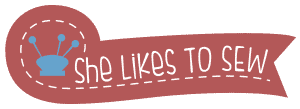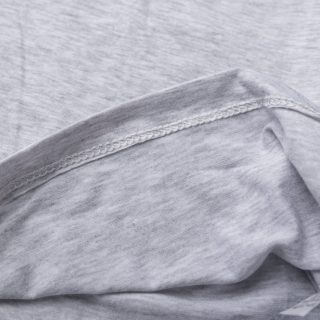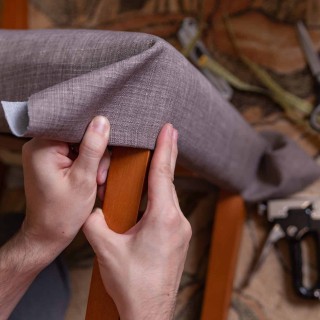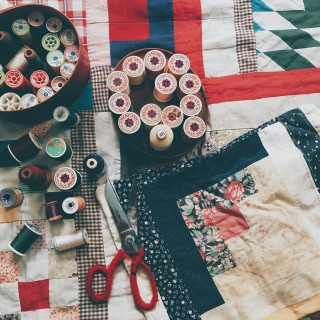Crazy about handicrafts?
Me too!
Have you tried a hand sewing project yet?
Hand sewing is one of the most relaxing and calming activities I know. It may seem monotonous, but it’s actually meditative and creative at the same time. Besides, it’s also super addictive. Once you begin to hand sew stuff, it’s hard to stop seeing all the things in the world that a little hand sewing can fix.
Here are some of my favorite easy hand sewing projects for beginners, perfect for you if you’re new to hand sewing. For those with more experience, these will come as fun and fast exercises, while for those with less experience, these projects are perfect for working on a new skill.
Hand Sewing Projects for Beginners
1. Pincushion
Start with an easy hand sewing project that will be both cute and useful: a pincushion. Trust me, after the first successful project, you’ll want to continue, so you’ll need a pincushion for your future projects.
Here’s what you need:
- 2 – 5 inch squares of fabric: 4 pieces, two contrasting pairs;
- Polyester fiberfill (for stuffing);
- Pencil;
- Needle;
- Matching color thread;
- Pins;
- Ruler/measuring tape.
How to Make a Pincushion?
- Lay down contrasting fabrics together on top of each other in two pairs.
- Trace the squares onto the “wrong” side (colored sides facing each other);
- Pin each pair together by putting the 2 needles in the center of the squares;
- Pins should be parallel to each other and about 1 inch from the center of the square;
- Mark ¼ of the inch with a ruler and sew a stitch from the edges of the square leaving around 1-inch opening;
- Sew until you are 1 inch from the beginning of your stitches;
- Repeat for the other pair as well;
- Watch out not to pinch yourself on the pins as you sew!
- Invert the fabric square and stuff it through the opening until it’s nice and plump;
- Use the back of the pencil to push the stuffing as much as possible;
- Close the remaining open end of the cushion with a matching thread;
- Push the needle one last time in the fabric and bring it out at the center of the cushion;
- Cut excess thread;
- Decorate further if you wish.
Watch this video to comprehend visually how to hand sew a pincushion.
2. Coasters
Simple, cute, and keeps your tables stain-free: something that most of us forget to put in use – coasters! But what if you’d have hand-sewn coasters that you’d be proud to display to your guests and happy to use as products of your skillful and artistic journey? I don’t think you will be forgetting them anymore.
Lucky for you, coasters are one of the easiest things to sew, and you can make plenty of them just for the sake of practicing needlework.
Fabric coasters have some advantages compared to other types of coasters. Your surfaces won’t get scratched, and plus, you won’t need to worry if someone spills the liquid a bit as the coaster will collect it, and then you can just wash it. Also, if you make it out of scrap fabric, it doesn’t really cost much, so who cares if they get discolored anyway?
Here’s what you need:
- Scrap fabric;
- Needle;
- Matching (or not matching) color string.
How to Make a Fabric Coaster?
- Cut your fabric into 5.5×5.5 inch squares where 0.5 inches is just extra maneuver space;
- Put two pieces of fabric together on the right side;
- Sew a string around the edges leaving a 1-inch opening;
- Trim the corners a bit;
- Turn the right side on the outside;
- Press the fabric;
- Make a topstitch around the outer edge.
3. Crayon Roll
A crayon roll is one of those easy sewing projects that are fun, creative, and useful. The crayon roll is best suited for crayons, but you can use it for other stuff as well.
Here’s what you need:
- 3 felt squares;
- Ribbon;
- Bias or elastic tape;
- Crayons for adjusting the dimension.
How to Make a Crayon Roll?
- Cut the two squares into 5 x 12 inches;
- Cut the third square into 3 x 12 inches;
- Cut two pieces of ribbon into 8 – 10 inch pieces;
- Stick the 5 x 12 inches pieces onto each other and on top of them put the 3 x 12 inches piece;
- Put the ribbon between the two 5 x 12-inch pieces on the right side of the long rectangle;
- Stitch all the way around the edges;
- Use a ruler to make marks at every inch;
- Sew straight lines bottom-up alongside those marks;
- Make several backstitches on top of each line so the stitches still hold strongly even after you put the crayons in.;
- Put your crayons in, roll them up, and tie them with the ribbon.
For a more visual explanation, check out this video on YouTube.
Coming up next is another 7 amazing products to sew, but for the step-by-step instructions, you’ll have to click on the links, as they come from other bloggers. I love getting tips from other sewers, so here are some of my favorite enthusiasts from the net.
4. Drawstring Bags
Having lots of remaining fabric or ripped clothes that you wanted to throw away? Don’t throw them away – reuse them!
Denim, cotton, linen, wool, even synthetics can all be used for making drawstring bags. Drawstring bags can have many purposes: you can use them as sunglass bags, cracker carriers, or for storing makeup, pencils, toys, and many other objects.
They are perfect organizers for your backpack or bag, but can also help you organize your drawers, shelves, bathroom, or kitchen.
If you’d like to check out a full tutorial on how to sew drawstring bags, feel free to check out this tutorial by The Sewing Session.
5. Zipper Pouch
If you’re a fan of small accessories, perhaps you’ve already wasted a ton of money on cute zipper pouches. Zipper pouches are another way to organize the contents of your bag, but you can also use them to keep your credit cards or change.
They’re not as easy to make as coasters or pincushions, but they’re definitely achievable for a beginner. Plus, you get to learn how to hand sew a zipper, too!
For a detailed explanation on how to sew a zipper pouch, here’s a tutorial by Heather Hand Made.
6. Face Mask
Although the global pandemic seems to be calming down, it seems like face masks are here to stay, at least for another couple of months, or maybe even years, who knows.
So why waste money and add to piles of trash with single-use masks, when you can make your own that matches your style?
There are different patterns for each type of face, and here you can find a pattern in PDF for toddlers, children, teens, women, and men, along with detailed instructions on how to make them.
If you need a guided tutorial, here’s one by Kristin Esser.
7. Notebook Pen Holder
This fabric hand-sewn notebook pen holder is much more than practical: it can look pretty amazing and can be a great gift for a friend who likes to journal a lot, but often forgets their pen at home.
You can make this easy hand sewing project out of leather, especially if the notebook you want to fit it on is stylish and has leather covers. But you can also use other types of fabric such as cotton, linen, or synthetics. You can decorate the penholder using buttons, glitter, stickers, etc.
Here’s a detailed tutorial on how to hand sew a notebook pen holder by Made to Be a Momma.
8. Fabric Bookmarks
These are another amazing gift for your book-loving friends, and a great way to reuse leftover fabrics instead of throwing them in the trash.
Fabric bookmarks are quite easy to make – you can check out these instructions by The Crafty Mommy. Still, they can look amazing especially if you decide to decorate them by adding some patchwork, buttons, or maybe stripes on the fabric.
9. Gift Bag
If you’re looking to pack a gift for your friend or loved one in the most creative package that will remain cool and useful even after unfolding, these might be a perfect choice.
Stylish, simple, and environmentally friendly, this gift bag is maybe even more exciting on its own than the gift inside!
One of the best gift bag tutorials I know comes from Fabricartdiy, so I strongly recommend using it for your gift bag hand sewing project.
10. Handle Potholder
Simple and genius: handle potholder is everything we’ve always needed in the kitchen. Why use those impractical, towel-like potholders or gloves, when you can simply put a piece of stuffed fabric around the handle and touch it with your bare hands without getting burned!
Want to learn how to make it? Check out this exciting tutorial by Mary Martha Mama.
Summary
These are my top 10 hand sewing projects for beginners, and I hope you liked them. If things don’t go well the first time, make sure to keep practicing, as sewing is a skill, and the phrase “practice makes it perfect” applies here as well.
For more ideas on sewing projects, feel free check out the Sewing Blog section on my site to read more guides.







